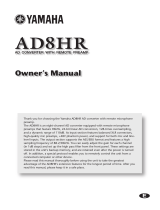
- 5 -
TF series Quick Guide
1. Precautions
PLEASE READ CAREFULLY
BEFORE PROCEEDING
Please keep this manual in a safe place
for future reference.
WARNING
Always follow the basic precautions listed below to
avoid the possibility of serious injury or even death
from electrical shock, short-circuiting, damages, fire
or other hazards. These precautions include, but are
not limited to, the following:
Power supply/power cord
• Donotplacethepowercordnearheatsourcessuch
as heaters or radiators, and do not excessively bend or
otherwise damage the cord, place heavy objects on it, or
place it in a position where anyone could walk on, trip over,
or roll anything over it.
• Onlyusethevoltagespeciedascorrectforthedevice.The
required voltage is printed on the name plate of the device.
• Useonlythesuppliedpowercord/plug.
If you intend to use the device in an area other than in the
one you purchased, the included power cord may not be
compatible. Please check with your Yamaha dealer.
• Checktheelectricplugperiodicallyandremoveanydirtor
dust which may have accumulated on it.
• Besuretoconnecttoanappropriateoutletwithaprotective
grounding connection. Improper grounding can result in
electrical shock, damage to the device(s), or even fire.
Do not open
• Thisdevicecontainsnouser-serviceableparts. Do not
open the device or attempt to disassemble the internal
parts or modify them in any way. If it should appear to be
malfunctioning, discontinue use immediately and have it
inspected by qualified Yamaha service personnel.
Water warning
• Donotexposethedevicetorain,useitnearwaterorin
damp or wet conditions, or place on it any containers (such
as vases, bottles or glasses) containing liquids which might
spill into any openings. If any liquid such as water seeps
into the device, turn off the power immediately and unplug
the power cord from the AC outlet. Then have the device
inspected by qualified Yamaha service personnel.
• Neverinsertorremoveanelectricplugwithwethands.
Fire warning
• Donotputburningitems,suchascandles,ontheunit.
A burning item may fall over and cause a fire.
If you notice any abnormality
• Whenoneofthefollowingproblemsoccur,immediately
turn off the power switch and disconnect the electric plug
from the outlet. Then have the device inspected by Yamaha
service personnel.
- The power cord or plug becomes frayed or damaged.
- It emits unusual smells or smoke.
- Some object has been dropped into the device.
- There is a sudden loss of sound during use of the device.
• Ifthisdeviceshouldbedroppedordamaged,immediately
turn off the power switch, disconnect the electric plug from
the outlet, and have the device inspected by qualified
Yamaha service personnel.
CAUTION
Always follow the basic precautions listed below
to avoid the possibility of physical injury to you or
others, or damage to the device or other property.
These precautions include, but are not limited to,
the following:
Power supply/power cord
• Whenremovingtheelectricplugfromthedeviceoran
outlet, always hold the plug itself and not the cord. Pulling
by the cord can damage it.
• Removetheelectricplugfromtheoutletwhenthedevice
is not to be used for extended periods of time, or during
electrical storms.
Location
• Donotplacethedeviceinanunstablepositionwhereit
might accidentally fall over.
• Donotblockthevents.This device has ventilation holes at
the top/front/rear to prevent the internal temperature from
becoming too high. In particular, do not place the device on
its side or upside down. Inadequate ventilation can result in
overheating, possibly causing damage to the device(s), or
even fire.
• Donotplacethedeviceinalocationwhereitmaycomeinto
contact with corrosive gases or salt air. Doing so may result
in malfunction.
• Beforemovingthedevice,removeallconnectedcables.
• Whensettingupthedevice,makesurethattheACoutlet
you are using is easily accessible. If some trouble or
malfunction occurs, immediately turn off the power switch
and disconnect the plug from the outlet. Even when the
power switch is turned off, electricity is still flowing to the
product at the minimum level. When you are not using the
product for a long time, make sure to unplug the power cord
from the wall AC outlet.
• Whentransportingormovingthedevice,alwaysusetwoor
more people. Attempting to lift the device by yourself may
damage your back, result in other injury, or cause damage
to the device itself.
Connections
• Beforeconnectingthedevicetootherdevices,turnoffthe
power for all devices. Before turning the power on or off for
all devices, set all volume levels to minimum.
Maintenance
• RemovethepowerplugfromtheACoutletwhencleaning
the device.
Handling caution
• Donotinsertyourngersorhandsinanygapsoropenings
on the device (vents, etc.).
• Avoidinsertingordroppingforeignobjects(paper,plastic,
metal, etc.) into any gaps or openings on the device (vents,
etc.) If this happens, turn off the power immediately and
unplug the power cord from the AC outlet. Then have the
device inspected by qualified Yamaha service personnel.
• Donotrestyourweightonthedeviceorplaceheavy
objects on it, and avoid use excessive force on the buttons,
switches or connectors.
• Donotuseheadphonesforalongperiodoftimeata
high or uncomfortable volume level, since this can cause
permanent hearing loss. If you experience any hearing loss
or ringing in the ears, consult a physician.
Backup battery
• Donotreplacethebackupbatterybyyourself.Doingso
may cause an explosion and/or damage to the device(s).
If the backup battery power is fully depleted, have qualified
Yamaha service personnel replace the battery.
Yamaha cannot be held responsible for damage caused by
improper use or modifications to the device, or data that is
lost or destroyed.






















